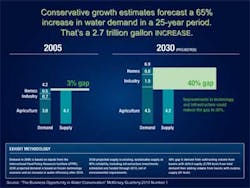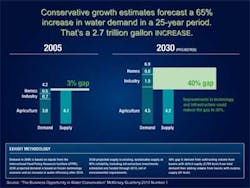The Future of Water
By Peter Mainz
As long as demand for water outpaces availability, water shortages will continue to be a fact of life. What's more, we could be looking at a worldwide water shortage of 40 percent by 2030, according to the 2011 United Nations Environment Programme Report. What's equally as disheartening is a World Bank report showing at least 35% of the world's water supply is lost due to leaking pipes.
It is clear that people and technology can work in concert to help manage and conserve the finite supply of fresh water so that everyone has access to clean water. The future of water will be managed by technology and implemented by water utilities and local municipalities. These stewards have a respect for our most precious resource, the vision to know what is required to protect it, the incentive to use it wisely and a commitment to ensure that their community has an abundant and affordable supply of clean, safe water. Unlike electricity, water cannot be manufactured or produced. The amount of water on Earth is finite and must be managed, measured and conserved as carefully as possible.
Water utilities, customers and technology share much of the responsibility. The integrated technology that supports a smart water network enables the communication that is necessary to automatically measure water use, monitor distribution lines for leaks and perform and manage a variety of field operations and infrastructure remotely through a single, two-way communications network.
Sensus brings that vision to life with AquaSense™—an intelligent water management solution that combines a powerful, dedicated wireless communications network that is based on open standards with advanced meters, software and services. With AquaSense, utilities can go beyond metering to true intelligent water management.
AquaSense spans a utility's entire operation. The accuracy of an AquaSense solution enhances revenue by reducing unaccounted for water.
Its communication and software functionality collects data and provides clear visibility into system status, increasing operational efficiency. And it helps further conservation efforts by using that data to proactively engage consumers in the water ecosystem.
If you ask a water utility employee about the connection between a communications network and customer service, they'll probably tell you that the network allows them to better serve customers by providing early leak notification, a simplified billing schedule and clear details about water usage. But one Chesterfield County Rural Water Company customer can also tell you how it helped prevent extensive water damage and provided details about a break-in and vandalism at his South Carolina hunting cabin.
Chesterfield's eight-hundred-plus square-mile territory serves twenty-two-thousand residents, comprised mostly of agricultural and poultry farms and dotted with small towns. At the start of each day, employees at Chesterfield receive notification of any issues that may have come up overnight. One morning, utility staff noticed continuous water use at a cabin owned by a local judge and immediately called him to alert him to a possible water leak. Upon visiting his cabin, he discovered it had been broken into and vandalized. After vandalizing the cabin and prior to leaving, the intruders turned on every water faucet in the cabin and left the water running.
Chesterfield's system detected the continuous water usage almost immediately. The customer called to thank the utility, saying that without notification of the leak, it would probably have been a few weeks before he went to the cabin and discovered the damage and running water. Based on the details of the water usage, law enforcement officials determined, within an hour, when the crime occurred. This accurate, documented time of occurrence was valuable information in catching the alleged criminals and prosecuting them.
The backbone of our AquaSense solution is the Sensus dedicated, wireless utility communications system. It is the technology base upon which different applications rest. It enables the communication exchange that is necessary to automate meter reading, monitor distribution lines for leaks, perform a variety of field operations remotely and interact with customers through home area networks.
When customers are given access to real-time data from their water utility, they're better equipped to understand their usage patterns and can then change their own behaviors to enable conservation. Our smart water networks can measure water flow down to a single drop, identify leaks and help utilities to capture water that previously went literally down the drain. The US Geological Survey estimates that nearly 6 billion gallons of water are lost each day due to leaks.
Today, we get data from smart meters and identify leaks in homes, businesses and a utility's supply line infrastructure. Tomorrow, we envision going well beyond these areas with technology to monitor and control utility operations beyond the meter, such as water quality, pressure monitoring and gray water.
There's much work to be done. In 2007, the EPA assessed the 20-year capital investment needed for the U.S. public drinking water system at more than $300 billion. Today, that cost is over $500 billion.
What's more, conservative growth estimates forecast a 65 percent increase in water demand in a 25 year period--that's a 2.7 trillion gallon increase.
The good news is that advancements in technology and infrastructure alone can reduce the gap by 10 percent.
And that's why the good work by water utilities and the customers they serve must continue.
We are already seeing the benefits of building smart water networks, as utilities have begun to save millions of gallons of water through more accurate measurement, preventive maintenance and leak detection. These smart water networks also give utilities tools that allow customers to actively participate in conservation programs to monitor and reduce their own water usage. So as the best and brightest minds in the field of water look for ways to address the global water crisis, I am encouraged by the partnership between people and technology to manage one of our most precious resources.
About the Author: Peter Mainz is CEO and President of Raleigh based Sensus, which provides smart meters, communication systems, software and services for electric, gas, and water utilities that enable the intelligent use and conservation of energy and water.

